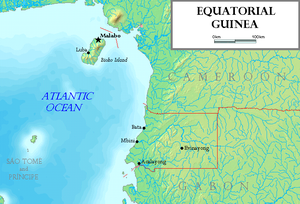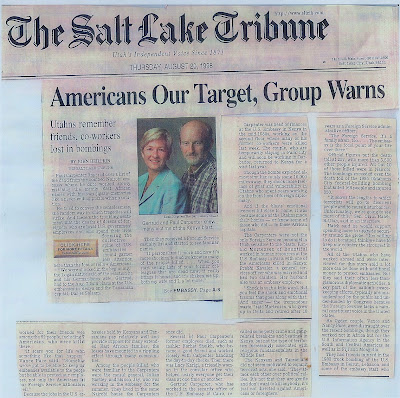This is my last stop on a five week sojourn in Africa. I'm in Malabo on the Island of Bioko in Equatorial Guinea, which was Spain's only colony in Africa. In colonial days Malabo was known as Santa Isabella and Bioko as Fernando Poo. Equatorial Guinea also has a piece of territory on the African mainland known as Rio Muni which lies between Cameroon and Gabon.
 | ||
| Map of Equatorial Guinea showing both Bioko Island and Rio Muni |
Since 1968 when the country became independent, Equatorial Guineans have lived under two repressive dictators, both stemming from the same family. The current president, Teodoro Obiang Nguema Mbasogo (http://en.wikipedia.org/wiki/Teodoro_Obiang_Nguema_Mbasogo is the nephew of the first president, Francisco, Marchias Nguema, who many considered insane and who on Christmas Day in 1975, has 150 coup plotters killed in the national stadium while a band played "Those Were the Days." For more on the country's sordid political history see the following link: http://en.wikipedia.org/wiki/Equatorial_Guinea#Politics
Shortly after independence, the State Department opened an embassy in Malabo and assigned two officers -- a charge' d'affairs and an administrative officer. The stress of opening an embassy on Fernando Po must have gotten to the Charge' as in 1971 he radioed the Embassy in nearby Yaounde, Cameroon to report that the Administrative Officer was involved in a communist plot. The embassy directed that the consul from Douala immediately charter a plane to Malabo and to take control of the embassy. Upon arrival he found that the charge' had killed the administrative officer in the embassy under very mysterious circumstances. It was a bizarre case that shocked Washington and led to the closing of the embassy which had only recently opened. The following two articles from the Foreign Service Journal review the murder and its aftermath.
I first heard about this murder shortly after entering the foreign service in the late 1970s and had no idea at the time that I would play a role in reopening embassy Malabo in the 1980s while I was posted in Yaounde. At that time Ambassador Hume Horan was accredited to both Cameroon and Equatorial Guinea and oversaw a team from Yaounde that helped set up the new embassy on a floor of Malabo's Hotel Impala. Despite Equatorial Guinea's close proximity to Cameroon, there were no scheduled flights to Malabo from either Yaounde or Douala. We therefore chartered a small plane to Malabo every few weeks to assist new staff that had been assigned there. At that time Malabo was the poorest place I had ever been and was without electricity or running water. The new embassy and the residence that was set up for the first resident ambassador ran off of Caterpillar generators 24 hours a day. It has often been said that one can tell how poor a place is from its garbage. There was virtually no garbage in Malabo and I never saw a dog, a cat, or a rat which says something about their source of protein. And when we were there for a few days, we never knew what we might find to eat in the island's few restaurants. Malabo is the only place I have eaten porcupine. Despite the poverty, there was virtually no crime due to people's fear of the violent police state they lived under.
The embassy we opened in the early 80s was closed for a second time a few years later as a budget cutting measure when it was determined that our interests in Equatorial Guinea didn't warrant a full time presence. However with the discovery of oil in 1996, an embassy was established for the third time and with a new US Government-owned chancery compound now under construction, we can now probably assume that a US presence will remain.
Equatorial Guinea has been the target for at least two coup attempts. The first, against former President Marchia, is said to be the setting for Fredrick Forseyth's book "The Dogs of War" which was made into a movie by the same name. The second, the so-called Wonga Coup, took place after oil was discovered. It was led by Simon Mann, an Englishman living in South Africa and the son of former British Prime Minister, Margaret Thatcher, is said to have helped finance this attempt.
Here are a few links related to these coups:
http://en.wikipedia.org/wiki/Frederick_Forsyth(see section on controversies)
With the discovery of oil in Equatorial Guinea, Malabo no longer resembles the place I visited in the 1980s. It is now crawling with international oilmen, businessmen and construction workers. A new four lane highway crosses the island and there are several first class hotels, including one with an 18-hole golf course. An impressive new hospital, staffed with more than 40 M.Ds from Israel also recently opened. On the surface, Malabo appears to be quite affluent but I doubt that the country's new found wealth trickles down very far and I believe that most of the population still remains very poor.






